Birding and Boat ride in Nalsarovar Bird Sanctuary
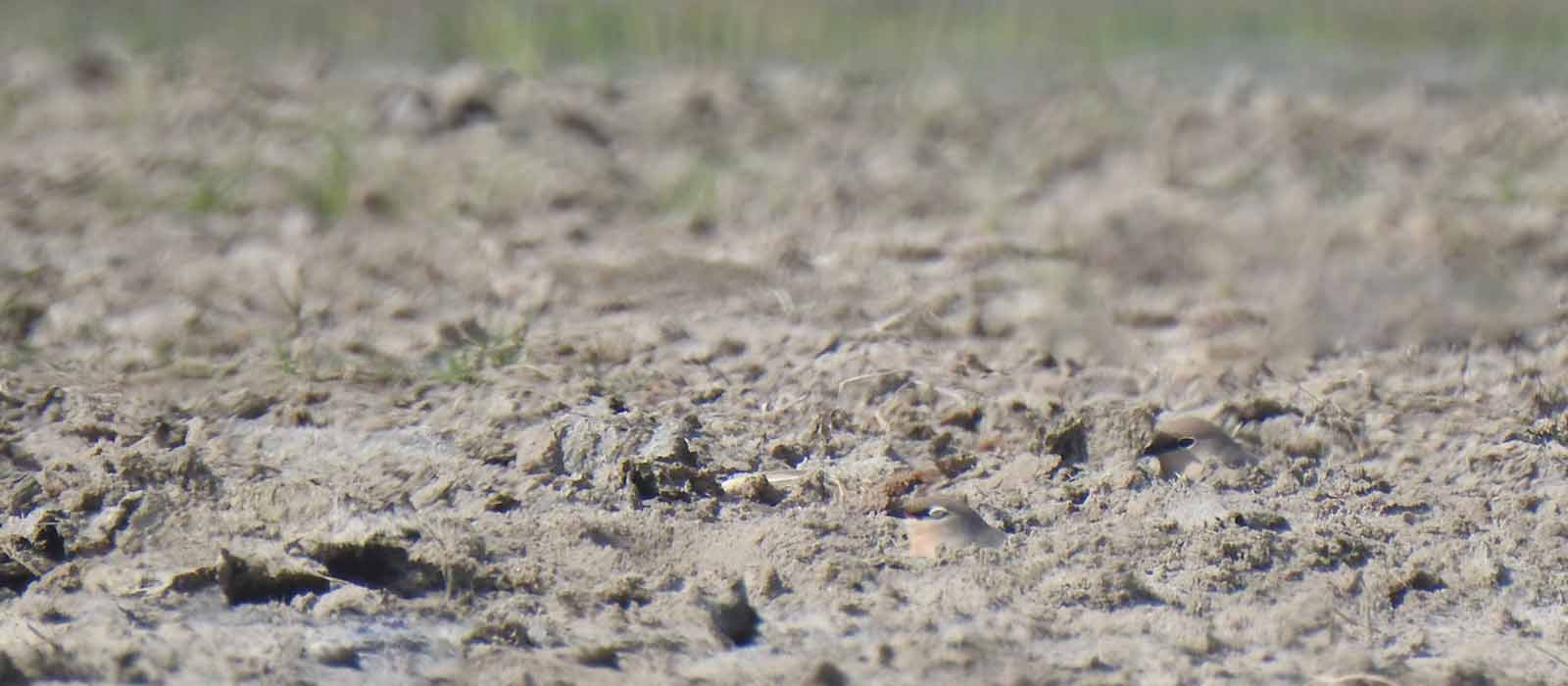
Small Pratincole camouflaged on the ground.These little ones were our aim for visiting Nalsarovar bird sanctuary
Our next stop from Blackbuck National Park was Nalsarovar Bird Sanctuary in our Gujarat Road Trip. Nalsarovar is located around 115 kms from Velavadar. Initially Nalsarovar was not in our plan but vinod thought it would be a good change of scenery if we visited wetland before heading to Kutch section. Nalsarovar is on the way to Little Rann of Kutch, so it was not much of a deviation from our route. We left Velavadar very early morning and reached Nalsarovar Bird Sanctuary at Sunrise. In Nalsarovar there are many small lakes and with the recent rain all the ponds and lakes were full in that region. The grasses were green instead of brown as in Velavadar. Local people were very busy with agriculture to use the good rains effectively. The water in the lakes were extracted using motor and pipes by the village people. We sighted few plovers on the agricultural fields. The Grey Wagtails were jumping around the grasses on the roadsides.
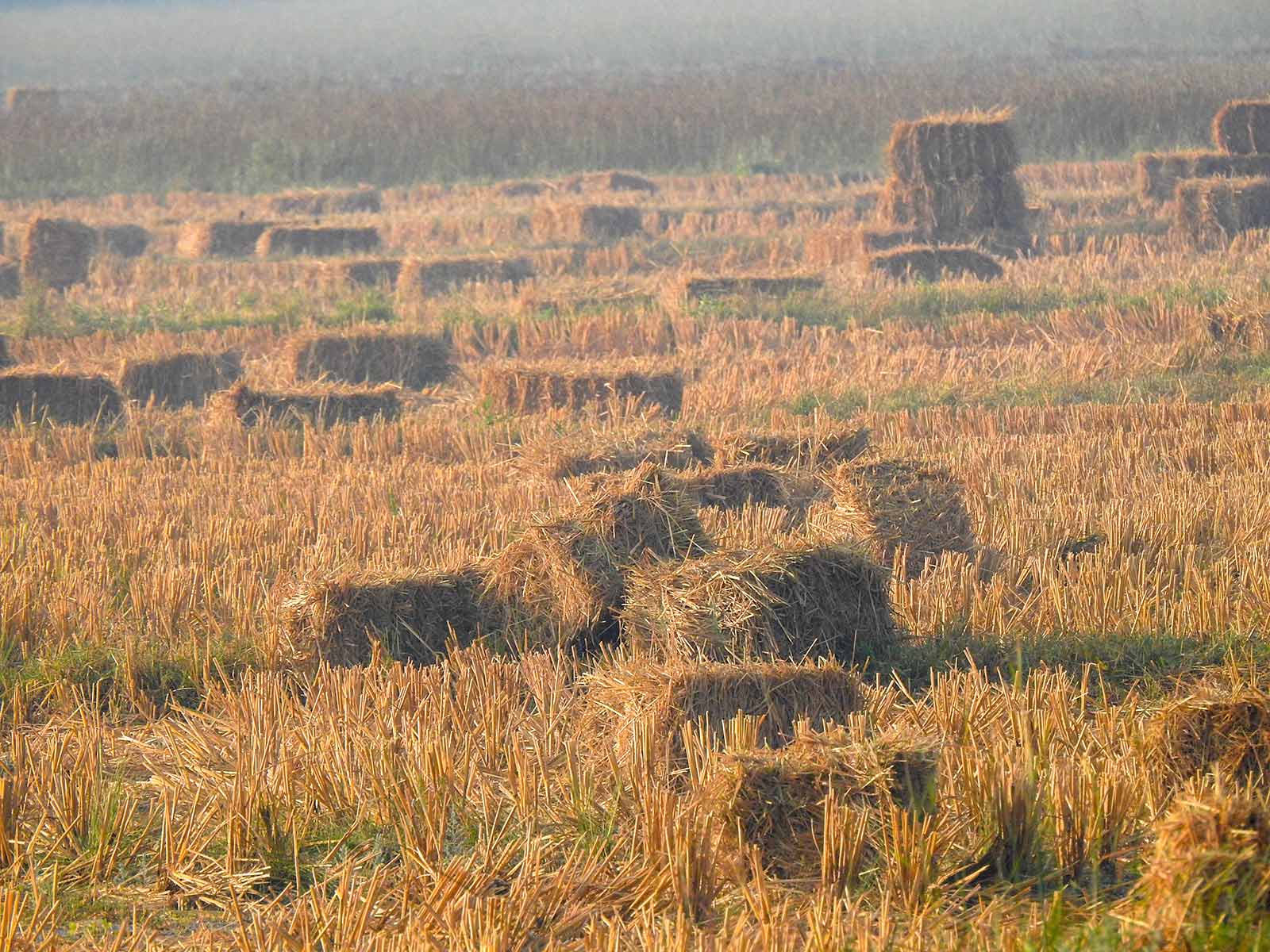
Early morning is the best time for everything. Even empty fields with harvested hay were glowing in the morning sunlight.
We stopped to look for birds and found some ducks in a pond but they were all far away. The place looked very lush and we forgot that we were in Gujarat for sometime. Vinod suddenly saw a red head amidst tall grasses and he joyously called me to meet our old friend Sarus Crane. We first saw Sarus Crane in Keolodeo National Park and I was thrilled to see a pair of them again in Nalsarovar. They were grazing calmly , we maintained our distance and watched them. Sarus Cranes are usually found in pairs but this time of the year most of the birds were moving around with their young ones, these Sarus Cranes were also not an exception. I thought we could sight more Sarus Cranes in this Gujarat Road Trip but only in Nalsarovar we saw Sarus Cranes. In all other places we sighted only Common Cranes not even Demoiselle Cranes which was a disappointment.
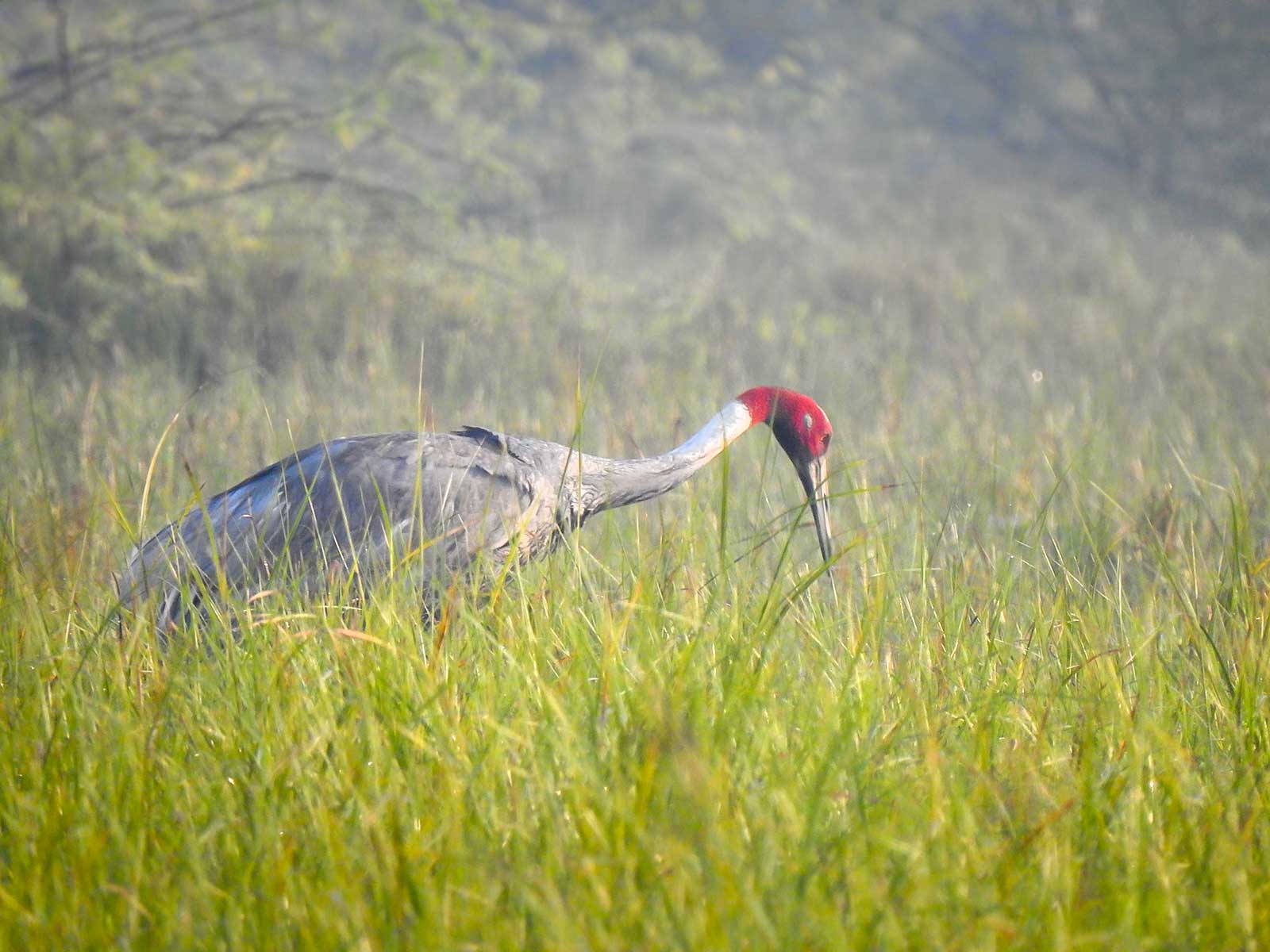
Sarus cranes are the tallest Indian birds , so they are visible even when they walk among tall grasses. While the morning light was still glowing these graceful beings were slowly wandering among the lush green grasses. It was a sight that will remain with me for a long time.
We reached Nalsarovar Bird Sanctuary entry and paid entrance fee. The official gave us big receipt forms but everything was written only in Gujarati, so we had no use with that piece of paper. We reached the boating place after stopping for few moments to see the birds in the waterbodies. We spotted many ducks and were pretty confident that we could sight some good number of birds if we go for boating. In the boating area we were surrounded by boatmen and there were different offers for the boating trip. Few other tourists were there but none came there for birding. They all just wanted to experience boating in Nalsarovar Lake. We on other hand wished to visit an island farther in the lake where there would be wonderful opportunity for birding. There were 36 islands in Nalsarovar Bird Sanctuary and based on our requirement the boatman will take us to specific islands. We just picked one boatman who told few bird names and he immediately called his crew members ( :D).
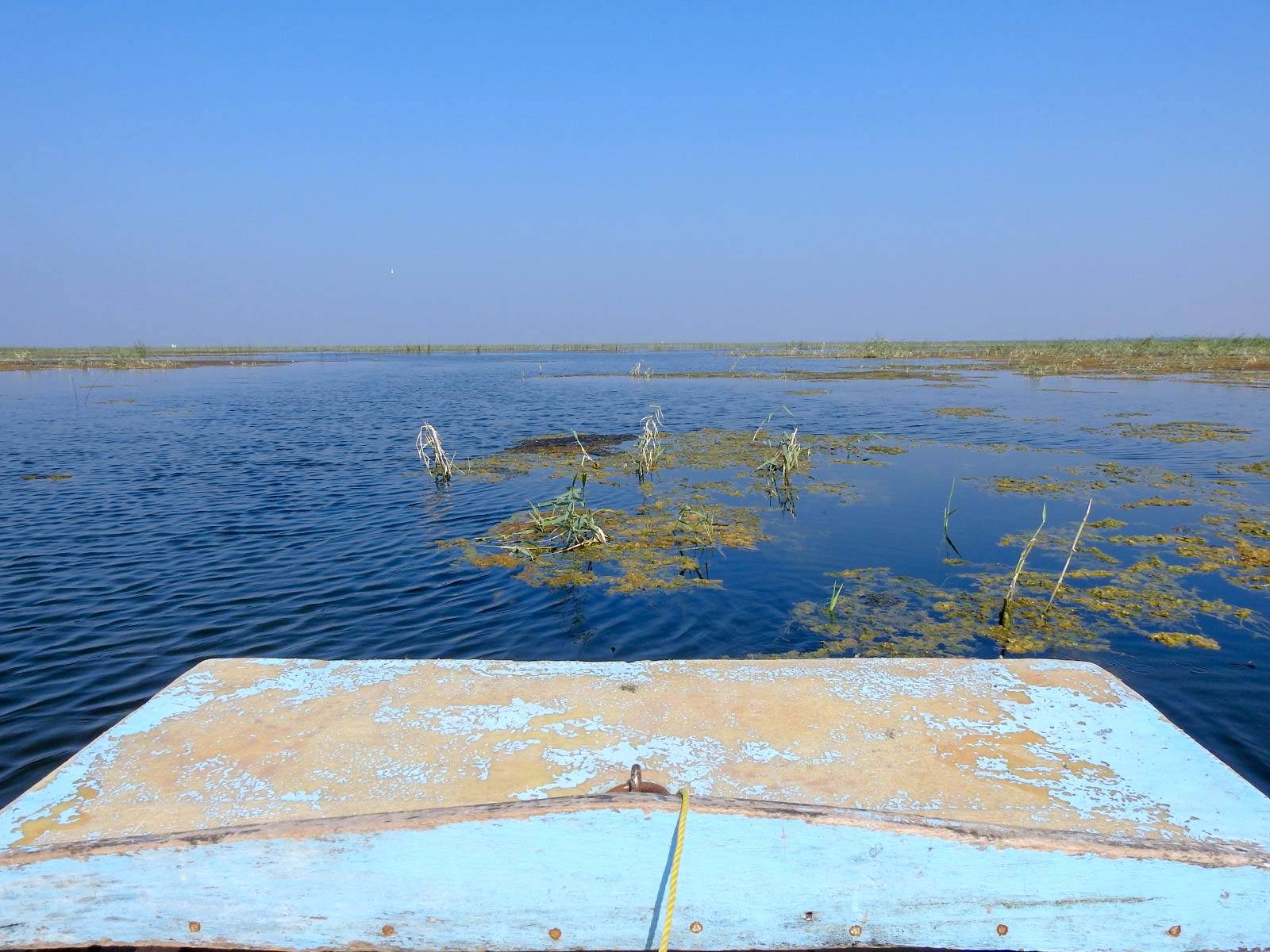
Unlike the motorboats used elsewhere , the boating in Nalsarovar was done by quanting. This meant that it was super quiet and very slow. The still blue waters added to the charm and I saw Vinod was relaxing rather than being in his usual alertness to see birds.
I was bit scared seeing the water level and the algae moving underneath it. We had no life jackets, so I know if the boat was capsized I was gone. I couldn’t concentrate with the surroundings for sometime while Vinod was excitedly watching the reeds and the unique ecosystem. Then the book “Where the crawdads sing” came to my mind and I remembered how Kya Clark “The Marsh Girl” survived the marsh alone , how she enjoyed her time with geese and gulls. I saw hundreds of Eurasian Coots infront of us and decided to enjoy the moment instead of thinking about safety. All the ducks were in high alert mode, so seeing the boat at a decent distance itself all flew away. In Pulicat lake it was always motor boats, so hearing the sound itself the birds flew away. Here it was a punt boat , so I thought we could go closer to birds but that didn’t happen.
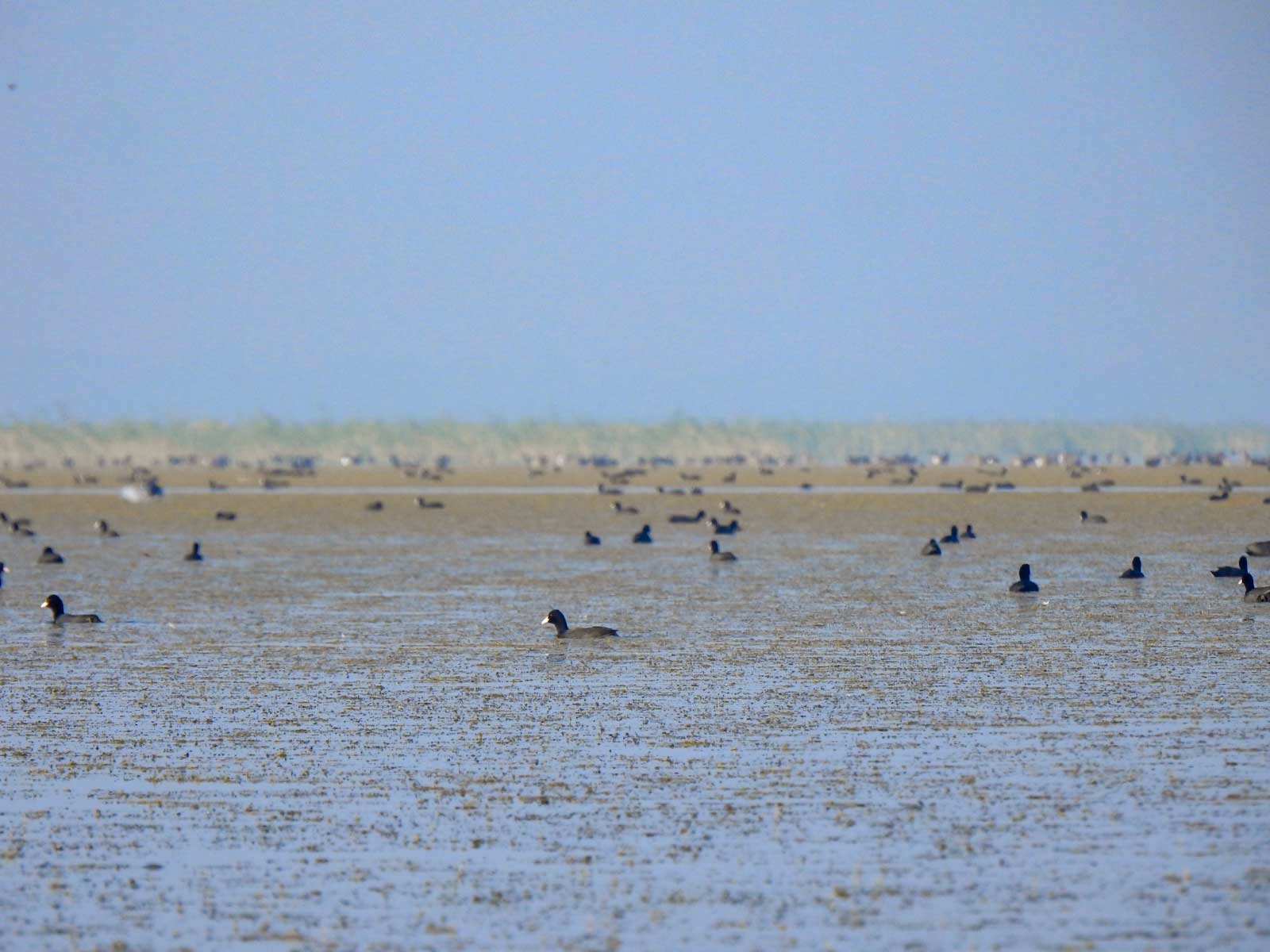
By far the largest number of birds found in the lake was the Eurasian coot. These birds looked liked dots all over the lake. While they were numerous , they were also shy of humans. They took off every time even when the boat turned in their vicinity. Getting as far away from humans is always a good survival strategy.
Only the yellow wagtails who were hopping on the reeds didn’t mind us. So it looked like after few minutes we chased out all the water birds and all we could see was water, reeds and ducks at distant in wavy lines. While I started regretting about taking this boat ride, I saw a duck with beautiful hairstyle not very far away. I showed it to Vinod and he was very excited to see the Crested Grebe which was a lifer for us. The Crested Grebes have beautiful plumage and mating behaviors which made them quite popular all over the world. These migratory birds usually come to India when they are not in their plumage color, still the one infront of us looked so beautiful.
Crested Grebes in Nalsarovar Lake
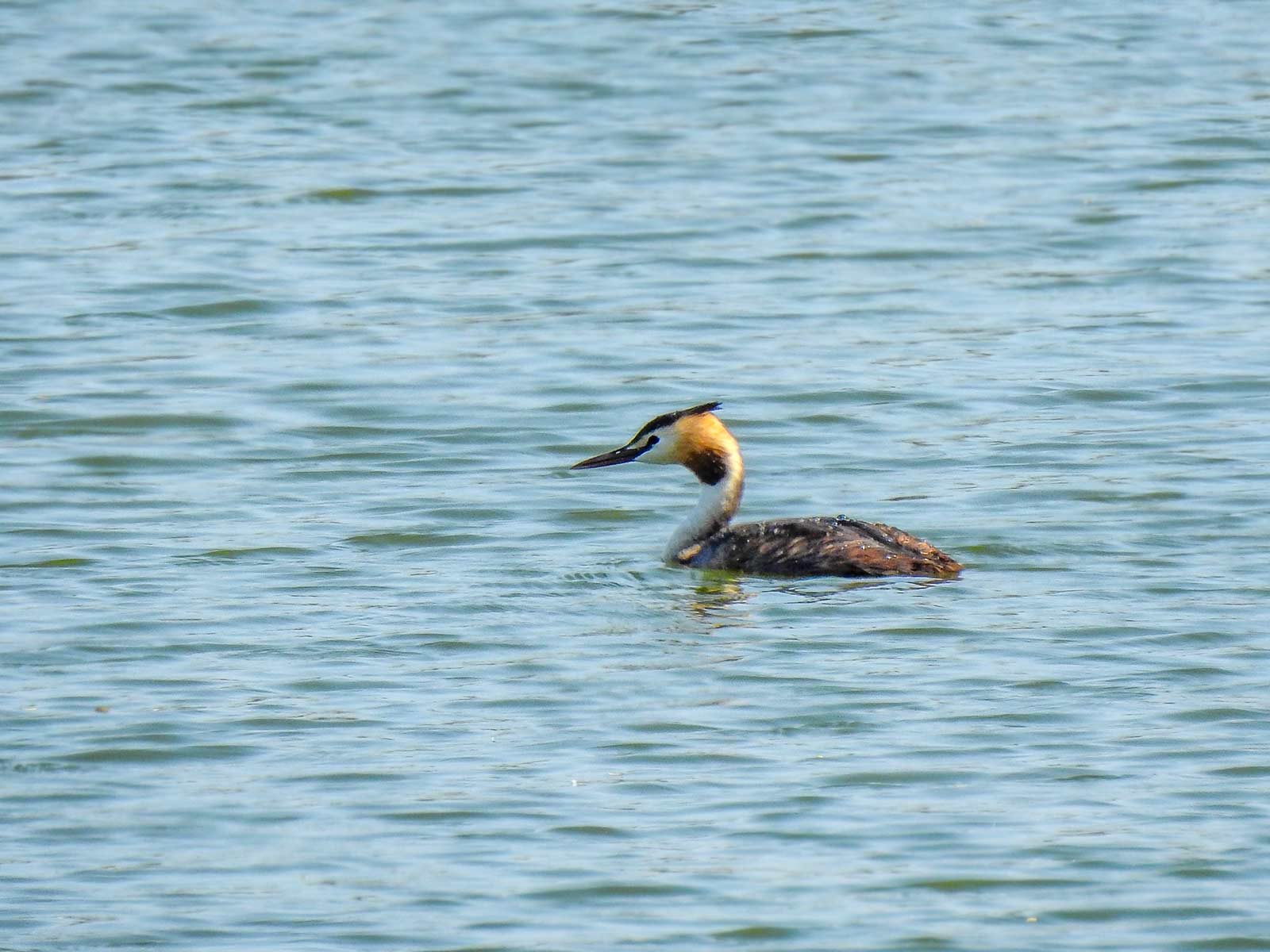
These beautiful birds are more beautiful when they are in breeding plumage. We were happy to have found this guy and furthermore that he had still retained some of his breeding charm.
The excitement of seeing Crested Grebe brought me back to birding mode. We reached a small island shortly. We found Western Marsh Harrier sitting peacefully on a stick. We clicked few photos sitting on the boat itself. While the Marsh Harrier didn’t get disturbed seeing us, someone else quickly flew away infront us. We realized from the flight pattern, it was a falcon. Vinod quickly grabbed binocular and checked the bird who had now circled back to the same site from where he flew away. Vinod identified the bird as Peregrine Falcon while I tried to get a good look on the bird. Then the Peregrine falcon thought otherwise and decided not to stay on the island along with us and flew away. We didn’t get a photo of the Peregrine falcon but happy that we had a good look on the bird. By this time the Sun was full high, light was harsh but weather was not very hot as we were surrounded by water.
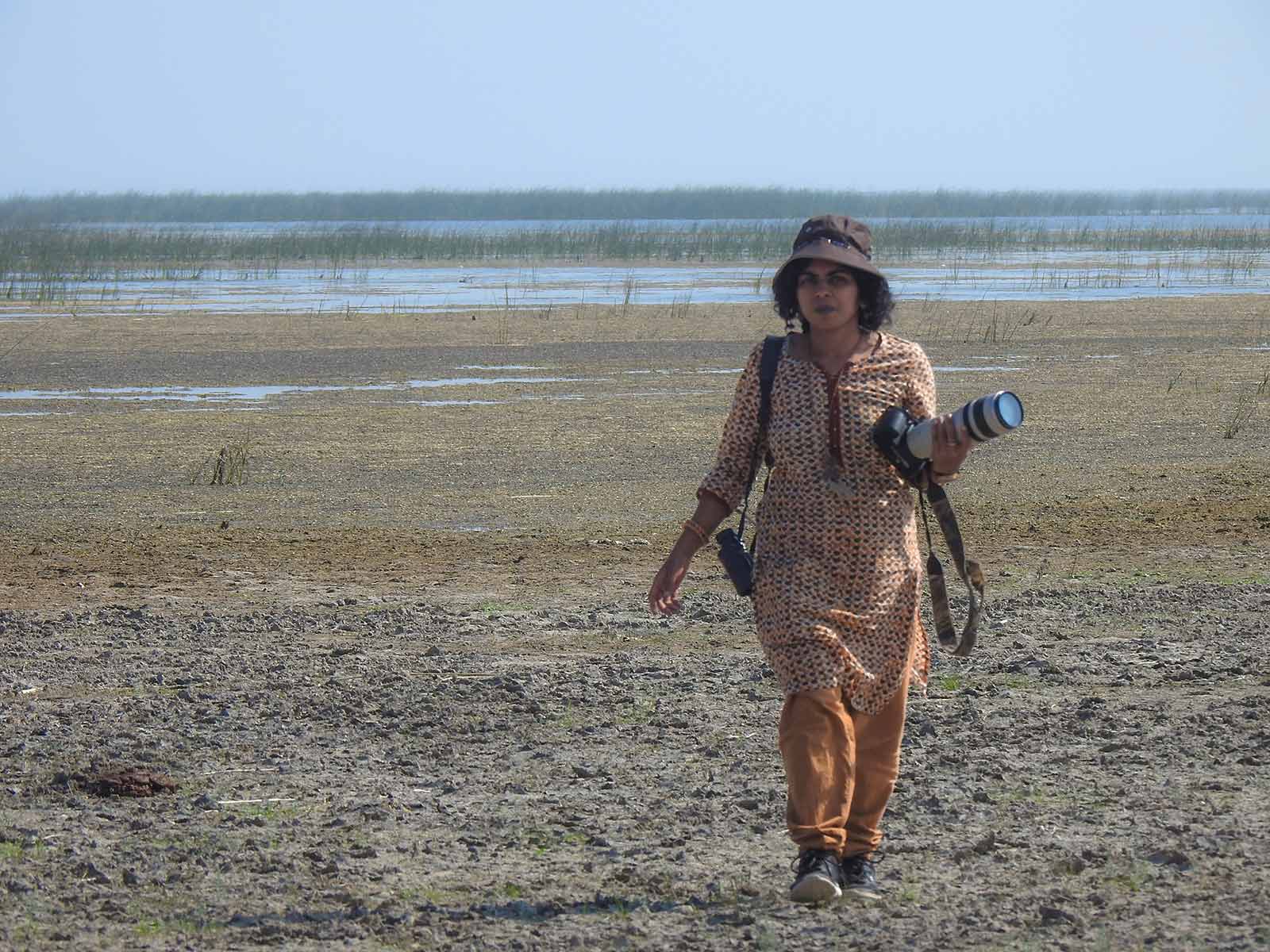
We were hopping from one island to another. Because the land is open and birds were shy we were having a hard time taking pictures of our target species. It was fun though ! The sun at this time was right above our head but it was only cool because of the surrounding water.
The boatmen offered me a local violet colored fruit and showed me how to unwrap the outer layer quickly. I cautiously bit a bite and it tasted familiar. It tasted like Palmyra sprout the famous “Panam kilangu” (பனம் கிழங்கு) in Tamilnadu. The boatmen told the local name is Singhara and I later found out that was the Water Chestnut which grows under water in marshes.
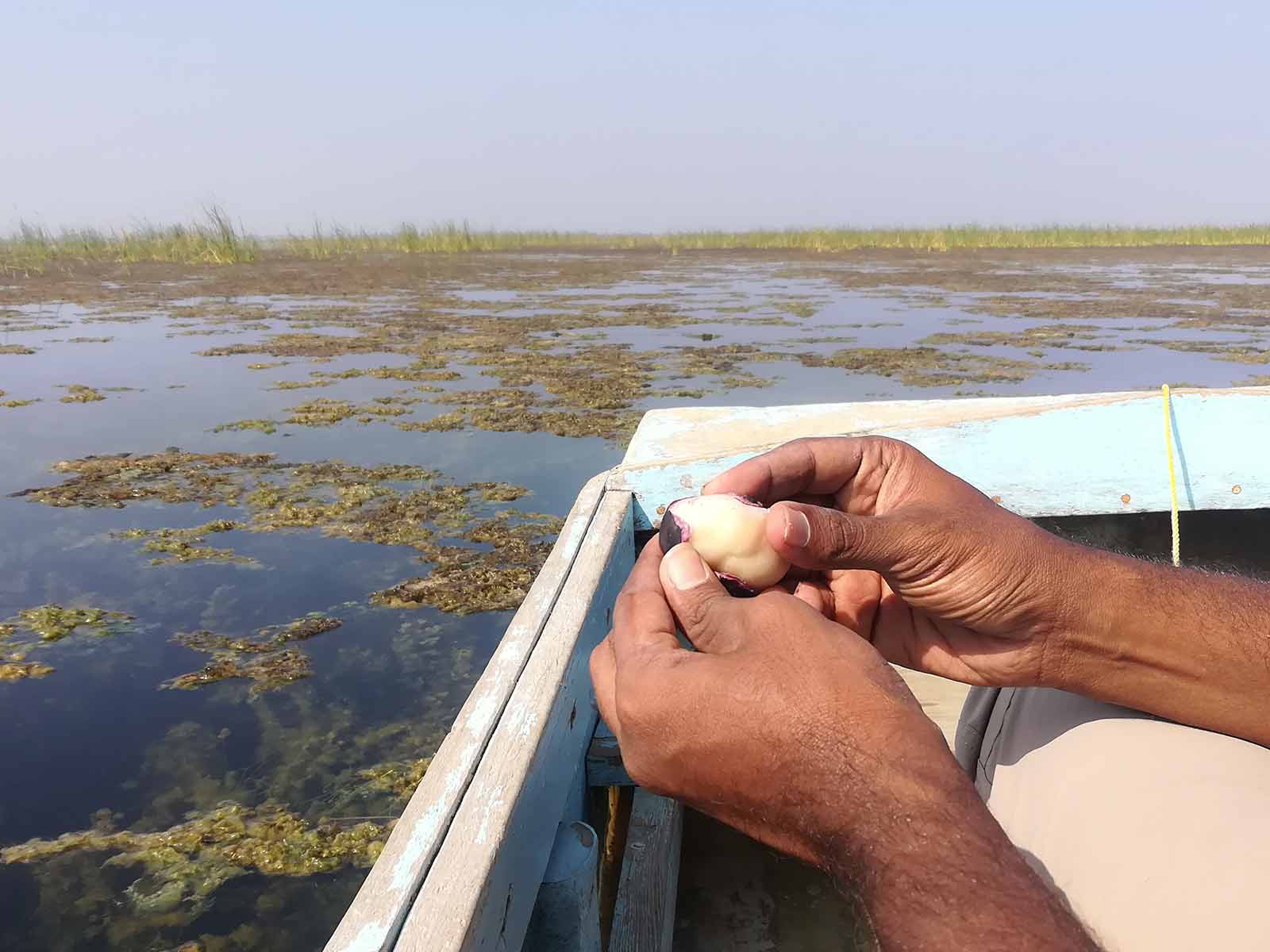
The boatman gave us this purple colored thing for eating. We were looking at each other and thinking whether we should try or not. In times of confusion Vinod just eats it , so we did try something new.
I also learnt that local people were destroying the marsh habitat and growing water chestnut in the last remaining wetlands. That was how they were able to sell this water chestnut in every corner of the roads in rural Gujarat. Since both Water Chestnut and Palmyra Sprout tasted similar, they could have planted more Palm trees which support wide variety of birds instead of spoiling the marshlands.
We reached another small island in short amount of time and initially we couldn’t see any birds except for few plovers. Then looking closer we saw a flock of Collared Pratincole who were well camouflaged to that terrain.
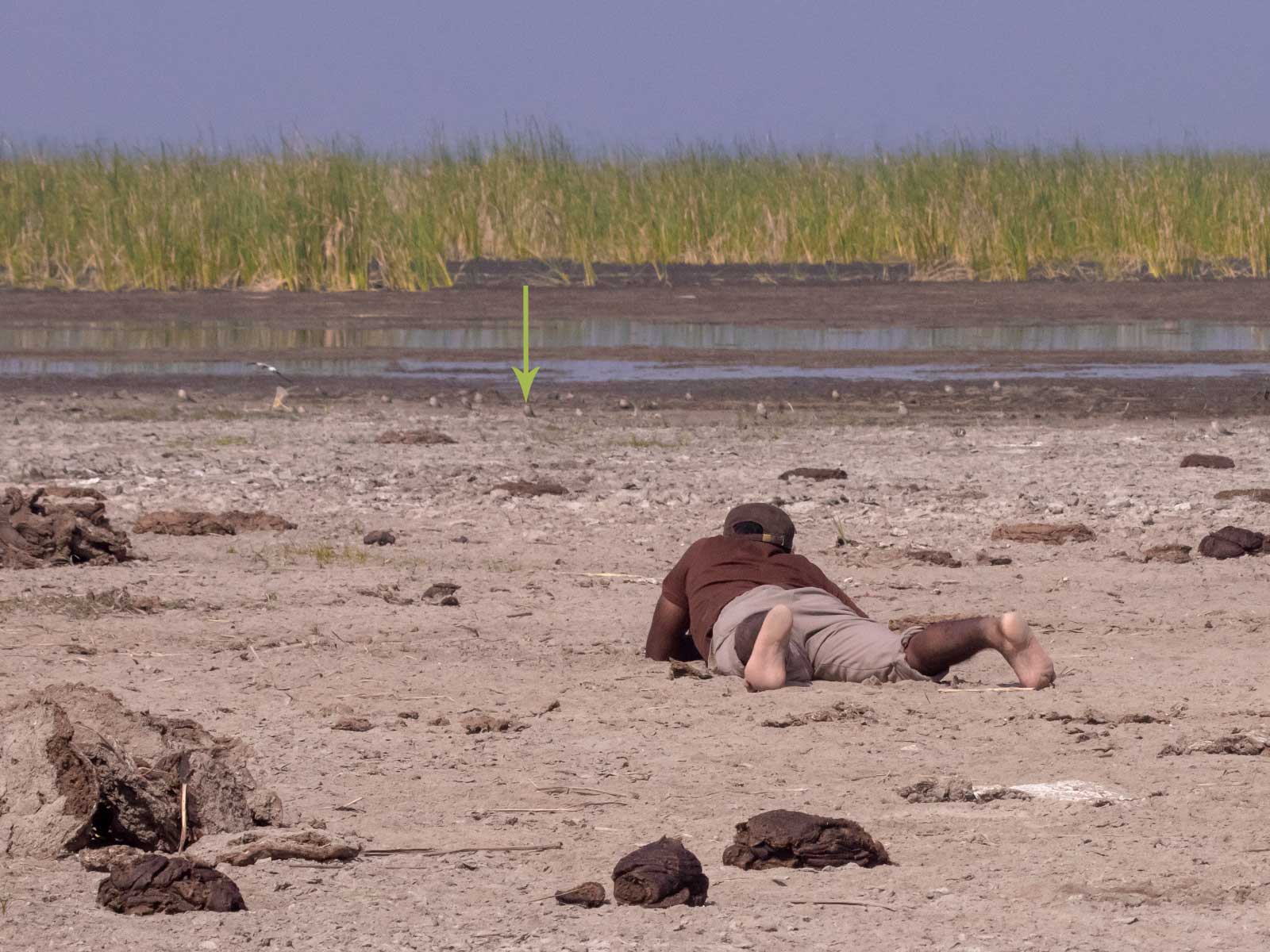
Sometimes when you approach birds by walking they tend to get scared and so we have crawl towards them. I left the crawling to Vinod amidst cow dungs and he came back with beautiful pictures 😛
There was a boy with his cows and a bed. These birds didn’t mind anyone as they were used to cow herders I believe. While I was watching the Collared Pratincoles, I saw in binocular something with long beak probing around in the front. I removed my binocs and saw it through the naked eye to confirm what I had seen. It was the elusive Snipe. The snipes are very secretive birds, so they are not usually seen in open lands. Here the bird was very casually moving around without much worry about its surroundings.
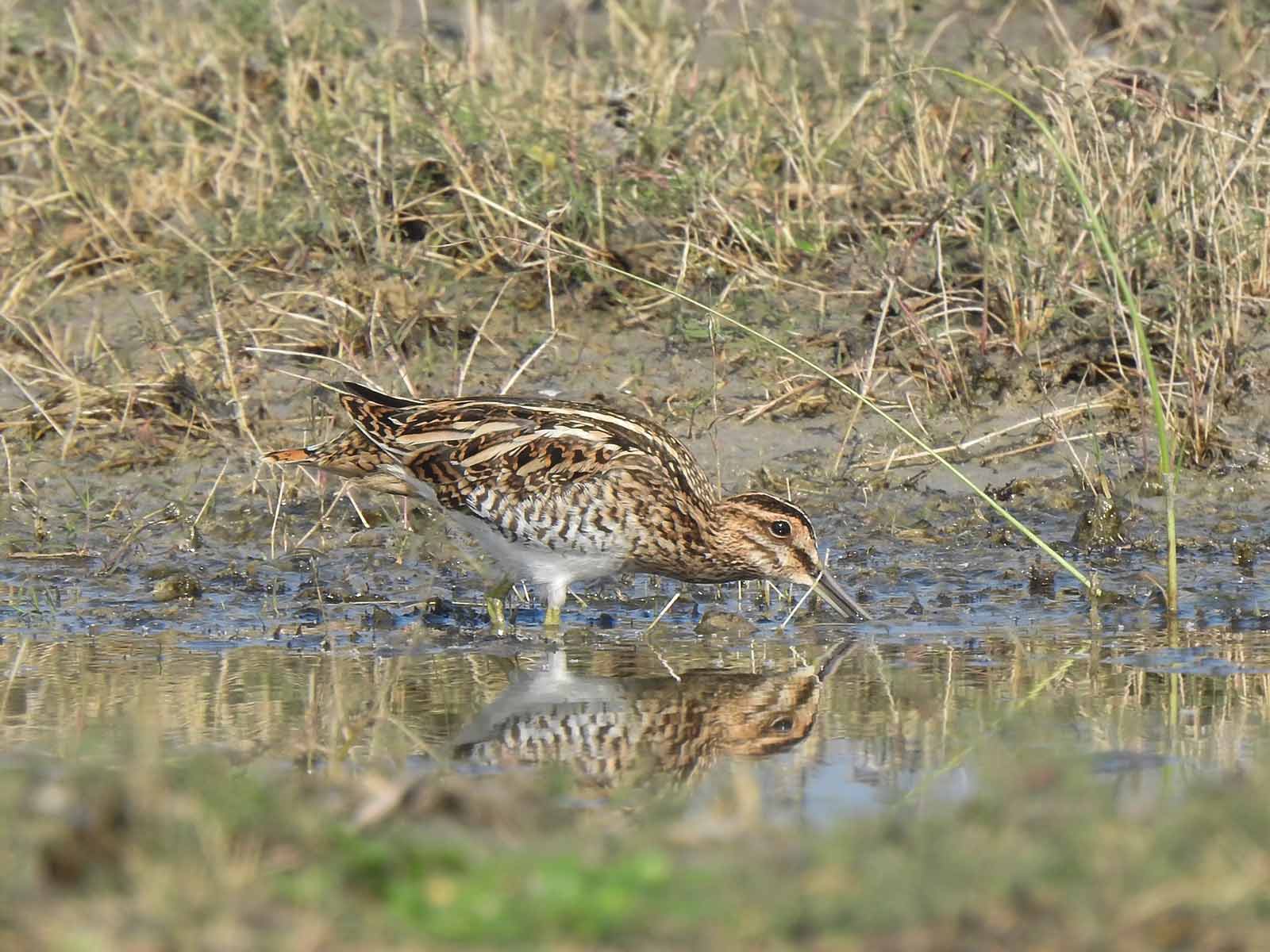
Always a elusive and reclusive one – the snipe was taking an exception and freely roaming around right in front of us.
Even though this place was very disturbed by humans, the birds didn’t seem to mind it which made us very happy. The boy who was hearing songs in his phone and herding his cows saw our activities without any interest. He should be used to birders in these islands.
We moved on to next island and we saw Bar-headed Goose, Brahminy Ducks and Ruddy Turnstone. We had seen these birds in our hometown itself, so we keenly looked at the small plovers furiously pecking around. We were closely watching the birds at the ground level and we spotted the well camouflaged Small Pratincole.
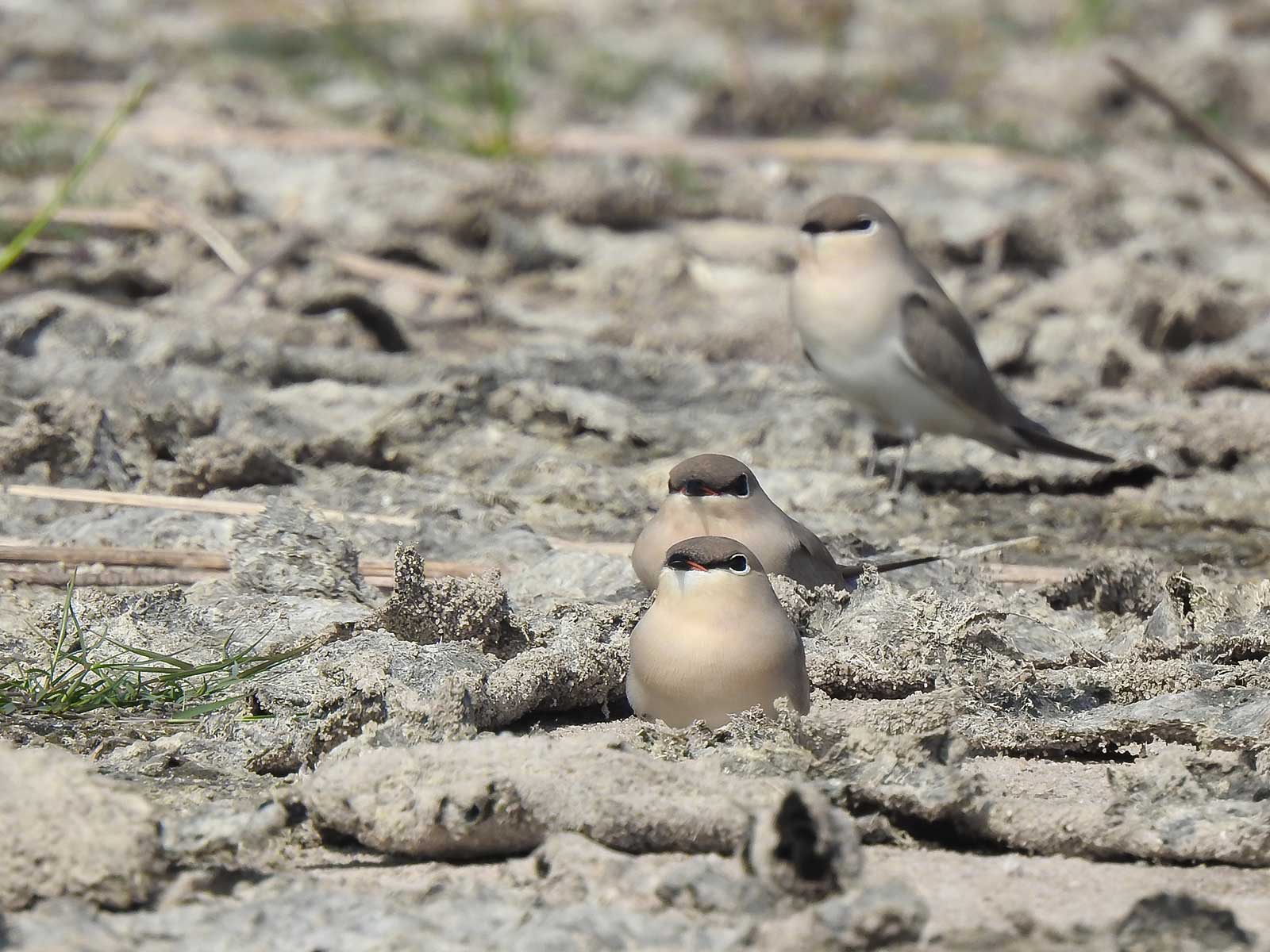
The cute ones we came for. These small pratincoles were superbly camouflaged and gave us a hard time spotting them. Even though they were camouflaged they were constantly checking the sky for predators which included the peregrine falcon we saw earlier.
Then we spotted another, another and another. There was a flock of Small Pratincole sitting on the ground which we didn’t notice at all when we got down from the boat. These Small Pratincoles were more sensitive than the Collared Pratincole and they flew away when we tried to go near. They circled and came back to the same location. We didn’t want to disturb them, so stayed at a safe distance and photographed them. After spending some time in that island, we decided to return back as we had to drive to Little Rann of Kutch. While returning back , I just enjoyed seeing the water and the reeds. It was a good decision to see wetlands before heading to the dry Kutch region in our road trip.
Good
The Nalsarovar wetland is huge in size. So it supports good number of wetland birds.
Bad
The Nalsarovar Bird Sanctuary was declared as Ramsar Site , still the human activities inside the Sanctuary was very high. There was cattle grazing in all the islands inside the sanctuary to the extent we even saw the herders were herding their cows using boats.
Ugly
All the lakes in the Nalsarovar region were full because of the good rains in Gujarat. But all waterbodies were drained out using motor pumps and pipes. Even small little ditches were being drained meticulously. As people engage in more and more intensive agriculture , we were not sure how long the waterbody can hold on to support the vast number of birds.
Glad to know that you really enjoyed reading it..Thanks for the detailed review!!
So much humour, observation and heart in your writing Mathi ! I followed all the hyperlinks and looked at the videos too ! Thanks for taking me on this journey to Nalsarovar and exposing me to all these birds ! Delightful read !